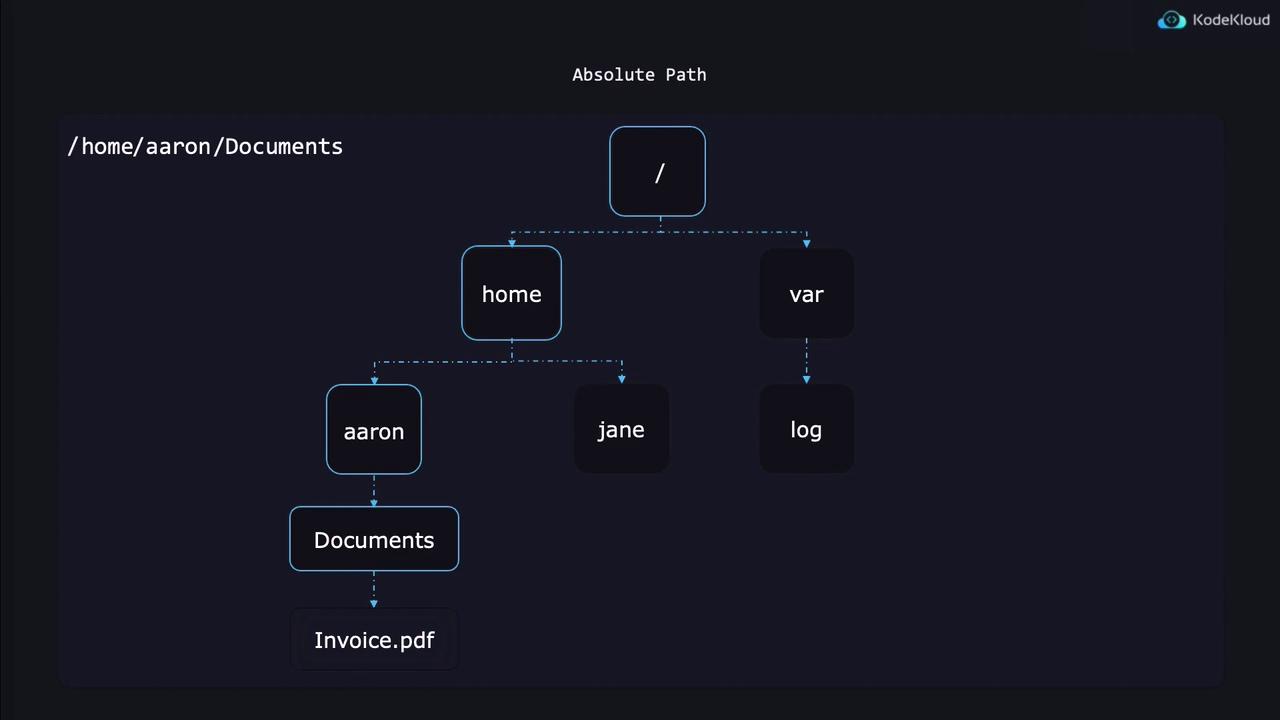Linux Foundation Certified System Administrator (LFCS)
Essential Commands
Create Delete Copy and Move Files and Directories
This guide demonstrates how to manage files and directories on Linux by creating, deleting, copying, and moving them. Before diving into the commands, ensure you understand these key concepts:
- File system tree structure
- Absolute paths
- Relative paths
Listing Files and Directories
To list files and directories—including hidden files (those starting with a dot)—use the ls -la command. The -a flag stands for "all" and the -l flag provides a detailed, long listing format. Here are some examples:
$ ls -la
$ ls -a
To list files for a specific directory, include the directory path:
$ ls /var/log
$ ls -l /var/log
The command ls -l /var/log displays detailed information such as file permissions, ownership, and modification dates. Combining options is also possible:
$ ls -ahl
total 76K
drwx------ 16 aaron aaron 4.0K Nov 1 17:57 .
drwxr-xr-x 7 root root 70 Oct 26 16:54 ..
-rw------- 1 aaron aaron 5.0K Nov 1 17:56 .bash_history
-rw-r--r-- 1 aaron aaron 18 Jul 27 09:21 .bash_logout
-rw-r--r-- 1 aaron aaron 141 Jul 27 09:21 .bash_profile
-rw-r--r-- 1 aaron aaron 376 Jul 27 09:21 .bashrc
drwxr-xr-x 2 aaron aaron 6 Oct 19 00:11 Desktop
drwxr-xr-x 3 aaron aaron 25 Oct 23 18:15 Documents
drwxr-xr-x 2 aaron aaron 6 Oct 19 00:11 Downloads
drwxr-xr-x 2 aaron aaron 6 Oct 19 00:11 Music
drwxr-xr-x 2 aaron aaron 2 Oct 19 00:11 Pictures
-rw-rw-r-- 1 aaron aaron 36 Oct 28 20:06 testfile
Tip
Using combined options like ls -ahl makes it quicker to view comprehensive file information.
Understanding the File System Tree
Linux organizes files and directories in what’s known as a file system tree. In this inverted hierarchy, the root is at the top and branches (subdirectories) and leaves (files) extend downward. The root directory is represented by a forward slash (/), and it forms the base for other essential directories such as home, var, and etc.
Absolute and Relative Paths
Absolute Paths
Absolute paths start from the root directory (/) and specify the complete location of a file or directory. For example, consider the following absolute path leading to a file named Invoice.pdf:
/home/aaron/Documents/Invoice.pdf

Relative Paths
Relative paths are defined in relation to your current working directory. To display your current directory, use the pwd command:
$ pwd
By default, you usually start in your home directory (e.g., /home/Aaron or /home/Jane). Changing directories can be done using the cd command:
$ cd /var/log # Uses an absolute path
$ cd .. # Moves up one directory level
Here, .. refers to the parent directory. For example, if you are in /home/Aaron, executing cd .. will take you to /home.
Relative Path Examples
Assume your current directory is /home/Aaron:
To access a file inside the
Documentssubdirectory:$ Documents/Invoice.pdfTo access a file in the current directory:
$ Invoice.pdfTo access a file located one directory above:
$ ../Invoice.pdf
You can chain .. to move up multiple levels (e.g., ../../Invoice.pdf moves up two levels).
Additional directory commands:
Switch to the root directory:
$ cd /Return to your previous directory:
$ cd -Return to your home directory:
$ cd
Creating Files and Directories
To create a new file, use the touch command. For example, to create receipt.pdf in the current directory:
$ touch receipt.pdf
You can create a file in another location using an absolute or relative path:
$ touch /home/Jane/receipt.pdf
$ touch ../Jane_receipt.pdf
To create a new directory, use the mkdir command:
$ mkdir receipts
Copying Files and Directories
The cp command copies files. You provide a source file and specify a destination. For instance, to copy receipt.pdf to the receipts directory:
$ cp receipt.pdf receipts/
Adding a trailing slash (i.e., receipts/) specifies that the destination is a directory. To copy and rename a file simultaneously:
$ cp receipt.pdf receipts/receipt_copy.pdf
To copy an entire directory with its contents, use the -r (recursive) flag:
$ cp -r Receipts/ BackupOfReceipts/
Important
Ensure the destination directory (e.g., BackupOfReceipts/) does not already exist when using recursive copying, as behavior may vary across systems.
Moving and Renaming Files and Directories
The mv command is used for moving files between directories or renaming them. Here are some examples:
To move a file into another directory:
$ mv Receipt.pdf Receipts/To rename a file:
$ mv receipt.pdf old_receipt.pdfTo rename a directory:
$ mv receipts old_receipts
Note that you don't need a recursive flag when moving directories; mv handles them by default.
Deleting Files and Directories
To delete files, use the rm command. For example, to remove Invoice.pdf:
$ rm Invoice.pdf
To remove a directory and all its contents, apply the -r flag:
$ rm -r invoices
Caution
Always double-check the command before running rm -r to avoid accidental deletion of important files or directories.
With these commands and explanations, you are now equipped with a solid foundation for managing files and directories in Linux. For additional Linux command cheatsheets and best practices, consider exploring more guides and tutorials online.
Watch Video
Watch video content